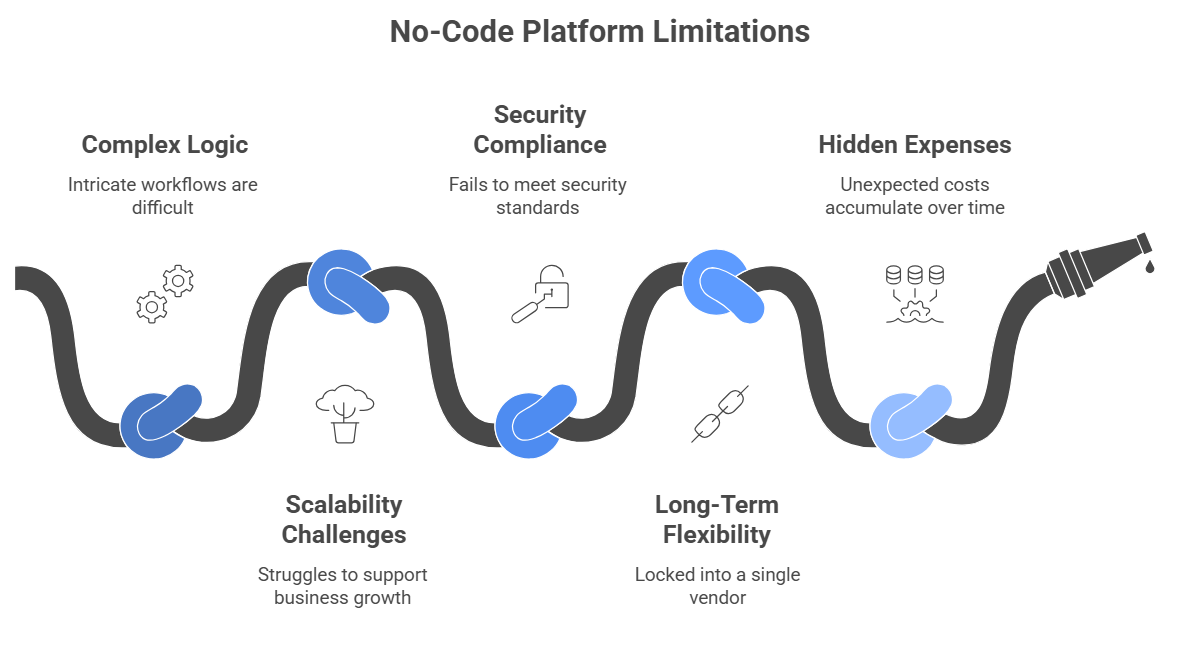No-Code and Low-Code: When to Use Them, When to Walk Away
In the digital race to innovate quickly, no-code and low-code platforms have become game-changers. These tools promise to eliminate technical bottlenecks by enabling teams to build applications with minimal or no traditional coding. They offer startups and non-technical users the ability to launch digital products quickly often in Week instead of months.
With benefits like cost savings, faster time-to-market, and democratized access to development, it’s no wonder businesses are increasingly leaning on these tools. But as more companies embrace no-code/low-code platforms, an important question emerges:
Are these tools right for every project, or are there times you should walk away?
Let’s take a deep dive into where these platforms truly add value, and where they can hold you back.
When No-Code and Low-Code Make Sense
No-code and low-code platforms are incredibly valuable in the right context. Here are the key use cases where these tools truly shine:
Fast MVP Development: Quickly Validate Your Ideas
- Why It Works: No-code tools are ideal for building Minimum Viable Products (MVPs). They allow startups to rapidly prototype, test core features, and gather user feedback without a heavy investment in development resources.
- Key Benefit: Save time and money, test your ideas faster, and pivot quickly based on user feedback.
Internal Tools and Automation: Streamlining Operations Without Overburdening Your Dev Team
- Why It Works: Internal tools such as dashboards, approval workflows, or project management systems are often straightforward to create with no-code and low-code platforms. These tools automate processes and manage data without the need for complex custom app development.
- Key Benefit: Empower non-technical teams to create solutions themselves, reducing dependency on developers and speeding up internal operations.
Limited Resources: Achieving Big Results Without a Full Dev Team
- Why It Works: Small businesses or departments without a dedicated development team can still create applications that meet their needs using no-code and low-code platforms. These tools provide affordable solutions without the need to hire full-time developers or agencies.
- Key Benefit: Save on development costs and empower teams to build applications independently.
Non-Critical Apps: When Simplicity Is Key
- Why It Works: No-code platforms excel at creating simple, non-critical applications, such as marketing landing pages or event registration systems. These types of apps don’t require advanced backend processes and can be built quickly.
- Key Benefit: Fast development for simple use cases, saving both time and money.
Empowering Non-Tech Teams: Enabling Self-Sufficiency
- Why It Works: Non-technical teams like marketing, HR, or operations can use no-code platforms to build applications tailored to their specific needs. This reduces reliance on IT and accelerates decision-making.
- Key Benefit: Improve operational agility and allow business teams to create tools and workflows independently.
When to Walk Away: The Limitations of No-Code Platforms
No-code platforms offer tremendous advantages for certain use cases, but they are not a universal solution. In many cases, the long-term limitations of these tools can outweigh the short-term benefits. Here are some key areas where no-code platforms fall short:
Complex Business Logic: No-Code Struggles with Intricate Workflows
- Why It’s a Problem: No-code platforms are great for basic apps, but they fall short when your app requires complex business logic, advanced workflows, or custom calculations.
- Example: A project management tool that involves multiple user roles, task dependencies, and approval hierarchies would be difficult to implement without custom code.
Scalability Challenges: Struggling to Support Growth
- Why It’s a Problem: No-code platforms often rely on shared infrastructure, which can lead to performance issues as your app’s user base grows. As your app scales, it may experience slow loading times, crashes, or failure to handle large amounts of data.
- Example: An app built for handling user-generated content or real-time interactions might struggle with scalability on no-code platforms, leading to poor performance and user experience.
Security and Compliance: No-Code Platforms Often Fall Short on Standards
- Why It’s a Problem: Industries like healthcare, finance, and government require stringent security measures and compliance with regulations like HIPAA and GDPR. No-code platforms generally lack the customization needed to meet these standards.
- Example: A healthcare app that needs to store sensitive patient data would require robust encryption, secure storage, and audit logs to comply with HIPAA, which no-code platforms may not provide.
Long-Term Flexibility: Locked into a Vendor
- Why It’s a Problem: No-code platforms often lock you into a specific vendor or ecosystem. You may not have access to the source code, and if the platform changes its pricing, terms of service, or features, it could affect your app.
- Example: If you’re building a critical business app, relying on a no-code platform can result in dependency on that vendor, limiting your flexibility and increasing costs in the long run.
Total Cost Over Time: Hidden Expenses Add Up
- Why It’s a Problem: While no-code platforms may seem cost-effective initially, the long-term costs can quickly escalate. Subscription fees increase with additional features, and as your app grows, you may need to hire developers to work around the platform’s limitations.
- Example: A small startup may start with a low-cost no-code tool, but as the app grows, they may need to upgrade to more expensive plans or bring in developers to handle advanced functionality, making the overall cost much higher than expected.

Decision: A Balanced Approach Is Best
The real takeaway? No-code and low-code platforms are incredibly valuable but only when applied strategically. They can provide significant value for specific use cases like MVP development, internal tools, and non-critical apps, but for more complex, scalable, and secure applications, custom development is often necessary.
At App Maisters, we help clients choose the right approach for their project by evaluating the specific needs and future growth of the application. Here’s how we typically recommend approaching different use cases:
| Use Case | Recommended Approach |
| MVP, Landing Pages | ✅ No-Code/Low-Code |
| Internal Tools | ✅ Low-Code |
| Customer-Facing Scalable App | ❌ Custom Development |
| Enterprise Integrations | ❌ Custom or Hybrid Development |
| Regulated Industry Applications | ❌ Custom Development |
| Multi-platform or API-heavy Apps | ❌ Custom Development |
We often blend both approaches using no-code for rapid front-end delivery and custom code for back-end scalability, integrations, or compliance.
How App Maisters Helps
At App Maisters, we don’t just offer development — we provide strategic technology solutions designed to drive your business forward. Whether you’re building a quick MVP or launching an enterprise-grade application, our expert team includes:
👨💻 No-Code/Low-Code Experts
🧠 Enterprise Architects and Full-Stack Developers
🔒 Security and Compliance Consultants
🚀 Product Strategy and Growth Advisors
We guide you to make the right choices for today while ensuring your solution is scalable for tomorrow. Let’s create something built to grow.
Conclusion: Making the Right Choice for Your Business
No-code and low-code platforms offer an invaluable solution for specific use cases, particularly when speed, cost, and simplicity are paramount. Whether you’re building a quick MVP, streamlining internal processes, or empowering non-technical teams, these platforms provide a fast and efficient way to get your application off the ground. However, they come with limitations that must be considered, particularly when scalability, security, and complex functionality are critical to your app’s success.
The key to success is recognizing when to leverage these platforms and when to turn to app development for more complex, scalable, and secure solutions. At App Maisters, we specialize in guiding businesses through this decision-making process, ensuring that your technology solution is the right fit for today’s needs while setting you up for future growth.
Whether you’re looking to prototype quickly with no-code tools or need a custom-built, enterprise-grade solution through custom app development, we’re here to help you make informed decisions that support your business goals. Let’s create a solution that works for you now and scales for tomorrow.
FAQs
What is a low-code no-code platform?
A low-code/no-code platform allows users to build applications using visual interfaces and minimal or no traditional coding, enabling faster development with simplified tools.
What are the benefits of low-code no-code?
These platforms offer faster time-to-market, reduced development costs, easier prototyping, and empower non-technical teams to build and iterate applications independently.
Can App Maisters scale a no-code app if my business grows?
Yes. App Maisters can help scale your no-code app by integrating custom code, optimizing performance, or transitioning to a fully custom solution as your needs evolve.
What are the features of low-code no-code?
Common features include drag-and-drop interfaces, prebuilt templates, workflow automation, database integration, and real-time previews of application changes.
Can App Maisters help migrate away from a no-code platform?
Absolutely. App Maisters specializes in transitioning businesses from no-code platforms to scalable, custom-built solutions tailored for performance, security, and growth.
What are the challenges of low-code no-code?
Challenges include limited customization, vendor lock-in, scalability issues, lack of support for complex logic, and potential security or compliance limitations.
Is low-code no-code the future of app development?
Low-code/no-code is a key part of the future, especially for rapid prototyping and internal tools. However, complex and enterprise-grade apps still require custom development.
Do low-code apps have strong security?
Security varies by platform. While many offer basic protections, they may fall short for high-compliance industries. App Maisters ensures your app meets proper security standards.
How does low-code or drag-and-drop interfaces speed up digital transformation?
By minimizing coding effort, these interfaces allow faster app creation, enable broader team involvement, and help organizations respond quickly to market changes and needs.




















